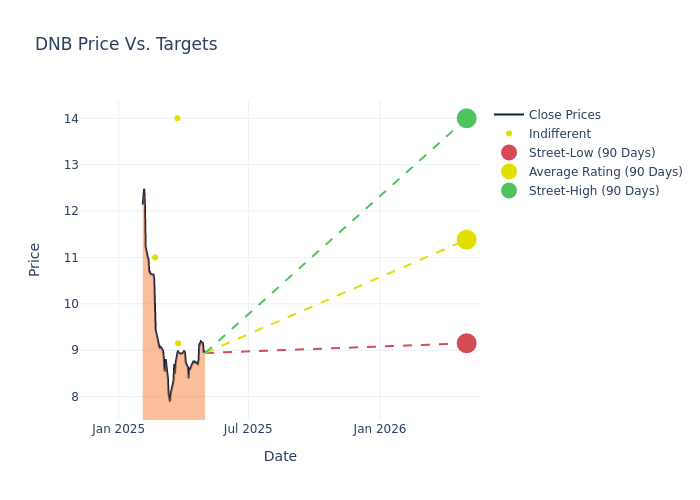Beyond The Numbers: 4 Analysts Discuss Dun & Bradstreet Holdings Stock
Across the recent three months, 4 analysts have shared their insights on Dun & Bradstreet Holdings (NYSE:DNB), expressing a variety of opinions spanning from bullish to bearish.
The following table encapsulates their recent ratings, offering a glimpse into the evolving sentiments over the past 30 days and comparing them to the preceding months.
| Bullish | Somewhat Bullish | Indifferent | Somewhat Bearish | Bearish | |
|---|---|---|---|---|---|
| Total Ratings | 1 | 0 | 3 | 0 | 0 |
| Last 30D | 0 | 0 | 0 | 0 | 0 |
| 1M Ago | 0 | 0 | 0 | 0 | 0 |
| 2M Ago | 0 | 0 | 2 | 0 | 0 |
| 3M Ago | 1 | 0 | 1 | 0 | 0 |
Providing deeper insights, analysts have established 12-month price targets, indicating an average target of $12.04, along with a high estimate of $14.00 and a low estimate of $9.15. Observing a downward trend, the current average is 12.12% lower than the prior average price target of $13.70.

Understanding Analyst Ratings: A Comprehensive Breakdown
An in-depth analysis of recent analyst actions unveils how financial experts perceive Dun & Bradstreet Holdings. The following summary outlines key analysts, their recent evaluations, and adjustments to ratings and price targets.
| Analyst | Analyst Firm | Action Taken | Rating | Current Price Target | Prior Price Target |
|---|---|---|---|---|---|
| Surinder Thind | Jefferies | Lowers | Hold | $9.15 | $11.00 |
| Kyle Peterson | Needham | Maintains | Hold | $14.00 | $14.00 |
| George Tong | Goldman Sachs | Lowers | Neutral | $11.00 | $12.80 |
| Kyle Peterson | Needham | Lowers | Buy | $14.00 | $17.00 |
Key Insights:
- Action Taken: Analysts adapt their recommendations to changing market conditions and company performance. Whether they 'Maintain', 'Raise' or 'Lower' their stance, it reflects their response to recent developments related to Dun & Bradstreet Holdings. This information provides a snapshot of how analysts perceive the current state of the company.
- Rating: Delving into assessments, analysts assign qualitative values, from 'Outperform' to 'Underperform'. These ratings communicate expectations for the relative performance of Dun & Bradstreet Holdings compared to the broader market.
- Price Targets: Analysts gauge the dynamics of price targets, providing estimates for the future value of Dun & Bradstreet Holdings's stock. This comparison reveals trends in analysts' expectations over time.
Analyzing these analyst evaluations alongside relevant financial metrics can provide a comprehensive view of Dun & Bradstreet Holdings's market position. Stay informed and make data-driven decisions with the assistance of our Ratings Table.
Stay up to date on Dun & Bradstreet Holdings analyst ratings.
All You Need to Know About Dun & Bradstreet Holdings
Dun & Bradstreet Holdings Inc is a provider of business decisioning data and analytics. The company operates in two segments: North America, which offers Finance & Risk and Sales & Marketing data, analytics, and business insights in the United States and Canada; and International, which offers Finance & Risk and Sales & Marketing data, analytics, and business insights directly in the U.K, Europe, Greater China, India and indirectly through its WWN alliances. The company generates maximum revenue from the North American region. Other services provided by the company include digital marketing, sales acceleration, and risk management among others.
Dun & Bradstreet Holdings: Delving into Financials
Market Capitalization Analysis: Positioned below industry benchmarks, the company's market capitalization faces constraints in size. This could be influenced by factors such as growth expectations or operational capacity.
Revenue Growth: Dun & Bradstreet Holdings displayed positive results in 3M. As of 31 December, 2024, the company achieved a solid revenue growth rate of approximately 0.24%. This indicates a notable increase in the company's top-line earnings. In comparison to its industry peers, the company trails behind with a growth rate lower than the average among peers in the Industrials sector.
Net Margin: The company's net margin is below industry benchmarks, signaling potential difficulties in achieving strong profitability. With a net margin of 1.23%, the company may need to address challenges in effective cost control.
Return on Equity (ROE): Dun & Bradstreet Holdings's ROE falls below industry averages, indicating challenges in efficiently using equity capital. With an ROE of 0.24%, the company may face hurdles in generating optimal returns for shareholders.
Return on Assets (ROA): The company's ROA is below industry benchmarks, signaling potential difficulties in efficiently utilizing assets. With an ROA of 0.09%, the company may need to address challenges in generating satisfactory returns from its assets.
Debt Management: Dun & Bradstreet Holdings's debt-to-equity ratio is below the industry average at 1.08, reflecting a lower dependency on debt financing and a more conservative financial approach.
The Basics of Analyst Ratings
Experts in banking and financial systems, analysts specialize in reporting for specific stocks or defined sectors. Their comprehensive research involves attending company conference calls and meetings, analyzing financial statements, and engaging with insiders to generate what are known as analyst ratings for stocks. Typically, analysts assess and rate each stock once per quarter.
Some analysts publish their predictions for metrics such as growth estimates, earnings, and revenue to provide additional guidance with their ratings. When using analyst ratings, it is important to keep in mind that stock and sector analysts are also human and are only offering their opinions to investors.
Which Stocks Are Analysts Recommending Now?
Benzinga Edge gives you instant access to all major analyst upgrades, downgrades, and price targets. Sort by accuracy, upside potential, and more. Click here to stay ahead of the market.
This article was generated by Benzinga's automated content engine and reviewed by an editor.